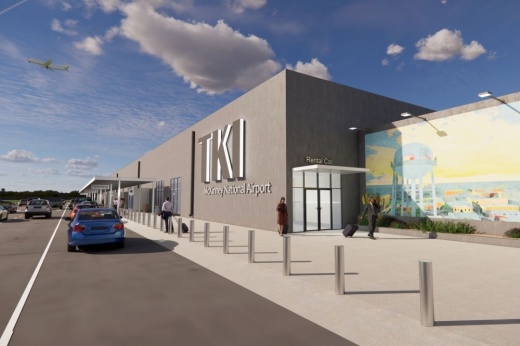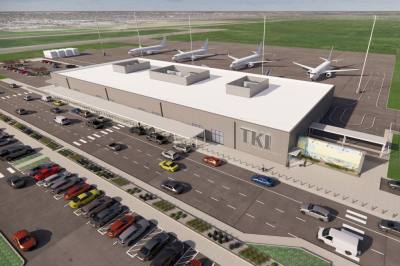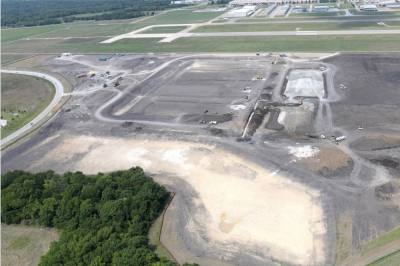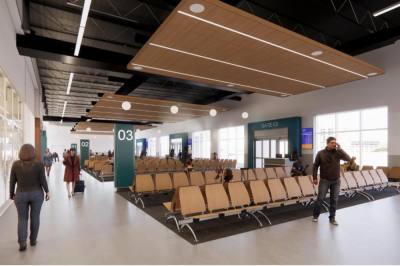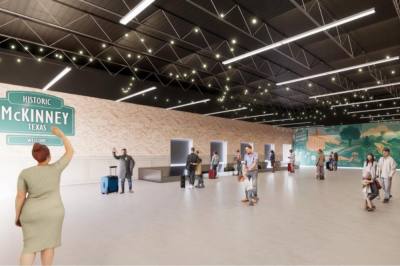McKinney officials broke ground on the passenger service expansion in July. The 46,000-square-foot terminal is expected to open in late 2026 and serve 200,000 passengers in the first year of operations.
The $79 million terminal and associated infrastructure that will be constructed are smaller than the original vision but will "capitalize on ... convenience" with short walking distances, Airport Director Ken Carley said. The terminal, which will begin with four gates, will have the capacity to expand to six gates, and will include onsite car rental facilities, concessions, and a 980-space public parking lot with the ability to expand to 1,450 spaces.
Avelo Airlines, a Houston-based ultra-low-cost carrier, has issued a letter of intent to provide service at the McKinney terminal, starting with up to three daily flights using a mix of Boeing 737 aircraft with a minimum capacity of 149 passengers, city documents state. The airline operates at over 50 airports worldwide and flies to Boston, Chicago, Las Vegas and Miami, its website states.
Negotiations are underway with three airlines, Assistant City Manager Barry Shelton said at an Aug. 19 McKinney City Council work session, noting that the city is subject to non-disclosure agreements regarding the airlines officials are negotiating with.
The cost
The project’s price tag will fund the cost of the terminal building as well as associated infrastructure such as the apron to park planes and the construction of a roundabout connecting the terminal to FM 546.
Project funding committed includes city funds, local grant funds and interim financing from the McKinney Community Development Corporation ahead of city officials securing federal low-interest loans. The Texas Department of Transportation also awarded $14.8 million in June for eastside airfield projects at the airport. The grant was approved when Gov. Greg Abbott signed the state’s two-year budget.
In an email, state Rep. Jeff Leach said he was “proud to help secure” state funding to make the “transformational project a reality.“ The money can be used for airport infrastructure projects that support commercial passenger service at the airport.
The terminal will “bring jobs, boost local businesses” and establish McKinney as a “major economic hub” in North Texas and beyond, Leach said. When completed, the terminal is expected to generate 360 jobs and more than $10 million in tax revenue impact in its first year of operations, city documents state.
How we got here
- May 6, 2023: McKinney voters reject $200M bond proposition to fund a larger vision for the commercial terminal
- Feb. 2024: Council members direct city staff to pursue other funding sources for the airport expansion
- May 2024: McKinney Community Development Corp. and McKinney Economic Development Corp. commit a total of $5.4M for project planning and design work
- Dec. 2024: Council members rezoned 280 acres on the airport’s east side for airport-related uses
- Jan. 2025: Site plan approval issued for the terminal project
- March 2025: McKinney Community Development Corp. and McKinney Economic Development Corp. commit a total of $52.4M for the project costs
- July 2025: Construction work begins on the terminal project
- Nov. 2026: Projected terminal completion and beginning of operations
Adding a passenger terminal to the McKinney National Airport would make it one of three airports in the Dallas-Fort Worth region with dedicated commercial service, alongside Dallas Fort Worth International Airport and Dallas Love Field Airport.
Program manager Ernest Huffman, who manages aviation planning for the North Central Texas Council of Governments, said the expansion will add to the region’s capacity for passenger travel. The region is projected to grow from about 8.6 million residents to 12.3 million by 2050, according to the NCTCOG’s Mobility 2050 plan. Much of that growth is expected to occur in Collin County, which is projected to increase population by 70%.
NCTCOG conducted an independent study around the time McKinney called a bond election to fund the expansion, Huffman said, which identified that the region is approaching capacity for passenger air travel.Maegan Escamilla, an East McKinney resident, community advocate and treasurer of the McKinney Legacy Neighborhood Association board, said the noise of planes overhead from current operations at McKinney’s airport is a common occurrence. While some louder planes and helicopters are noticeable from her home in the La Loma neighborhood, Escamilla said she more often hears the sound of cars driving through the neighborhood and on Airport Drive.
Escamilla said she is concerned about the increased road noise and traffic as the airport grows and travelers drive in the area. Adjacent TxDOT road projects that could assist with traffic incurred by the airport expansion will be completed after the terminal opens, such as an extension of Spur 399 to US 380 and a project to reconstruct SH 5, have projected completion dates that are years past the opening of the terminal.
“The airport is going to be done and ready for people, but the roads will not be and that’s going to create a lot more problems traffic-wise,” Escamilla said.
While the terminal will add some landings and departures at the airport daily, Carley said the addition of commercial service will not change the airport’s business model or “the impacts that the airport has in the community.”
The outlook
Construction is underway on elements of the project by construction company Swinerton, including excavation work and grading for the construction of the terminal building, plane parking apron, parking lot, fuel farm and other infrastructure.
Carley said the terminal could begin operations in November 2026. Announcements of the routes, destinations and rates for flights that will be offered at the airport are expected to be made about six months before the terminal opening. Confirmation of airline commitments could come later this year or in early 2026 when McKinney City Council considers airline operation agreements, Carley said.
“It’s a real project now,” he said. “In a sense, that’s kind of focused the airline’s interest a bit more, because they can see this is a real thing, it’s going to happen.”





